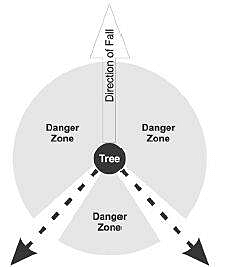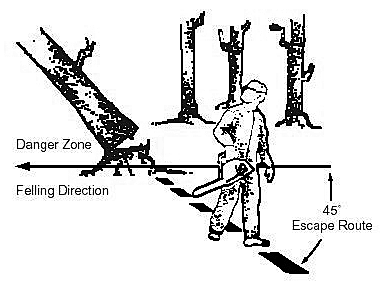It could be argued that the most important aspect of tree felling is the ‘escape route’. An escape route is simply a predetermined path of exit or retreat away from a falling tree. Preparations are made to clear the escape route by moving or cutting obstacles and brush that would cause the cutter to trip or stumble, or in any way obstruct or block the escape path.
Studies have revealed that 90% of all fatalities or injuries that occur to people when falling trees are within five feet of the stump or trunk (this occurs during the back-cut process). Further investigation shows that of these fatalities and injuries, they occur during the first 15 seconds from when the tree begins to fall.
...90% of all fatalities or injuries that occur to people when falling trees are within five feet of the stump or trunk...
The lesson to take from this study is the sooner and further a feller can distance themselves from the falling tree the better. In fact, the sooner a feller is more than five feet from the stump or trunk the chances of being killed or hurt is reduced by 90%. This is a very significant statistic and provides ample justification for selecting, preparing and using an escape route whenever falling trees. This information is the basis for the ‘5-15-90 Rule’. By taking these statistics into account, or in other words, by learning from others’ mistakes, we can improve our safety when felling trees.

Escape routes should be at an angle away from the direction of the fall. Due to reactive forces created as the tree begins to fall, limbs dead tops or a section of the trunk typically land right beside or behind the trunk or stump. Forces of gravity also play a role on the tree and its parts, as it tips and begins to fall.

Escape routes should be at an angle approximately 135 degrees from the direction of fall or 45 degrees opposite the direction of fall. While the specific angles are simply guidelines and rules of thumb, not specific measurements, they should still be considered when selecting and preparing your escape route. Downhill escape routes should be avoided, as logs and trees can roll. Also, whenever possible, get behind a strong barrier such as another tree. Select and walk the escapeEscape routes should be at an angle approximately 135 degrees from the direction of fall or 45 degrees opposite the direction of fall. (Image #2) While the specific angles are simply guidelines and rules of thumb, not specific measurements, they should still be considered when selecting and preparing your escape route. Downhill escape routes should be avoided, as logs and trees can roll. Also, whenever possible, get behind a strong barrier such as another tree. Select and walk the escape route prior to cutting, or in other words, do a practice run to ensure that it is free and clear of any obstructions.route prior to cutting, or in other words, do a practice run to ensure that it is free and clear of any obstructions.
Another important consideration is to ensure that any bystanders are well clear of the drop zone. The best place for everyone else to be during the felling process is two tree lengths away. This distance is derived from evidence that shows that tree parts that fall from a falling tree or that are explosively released upon impact can travel great distances. This is also why the feller should not stop retreating down the escape route after only five feet. It is safest to keep on making as much distance as fast as possible between you and the falling tree.
The best place for everyone else to be during the felling process is two tree lengths away.
Remember to always plan, prepare and practice your escape route when felling a tree and you will improve your safety by 90%. My office recently received an e-mail from a past student, telling us that a family member was killed tragically while felling a tree. The student is an arborist who has attended our training, and indicated that the main reason for the tragedy was that the 5-15-90 Rule was not considered, and no escape route was planned or prepared by the casualty.
It is wise to learn from others’ mistakes, as we do not have enough time or lives to make them all ourselves. In sharing this information, it is my intention to educate people on the dangers and realities of felling trees in order to provide ways to help you avoid making serious mistakes or suffer tragic accidents.
by Dwayne Neustaeter
Arboriculture Canada Training and Education Ltd. www.arborcanada.com

